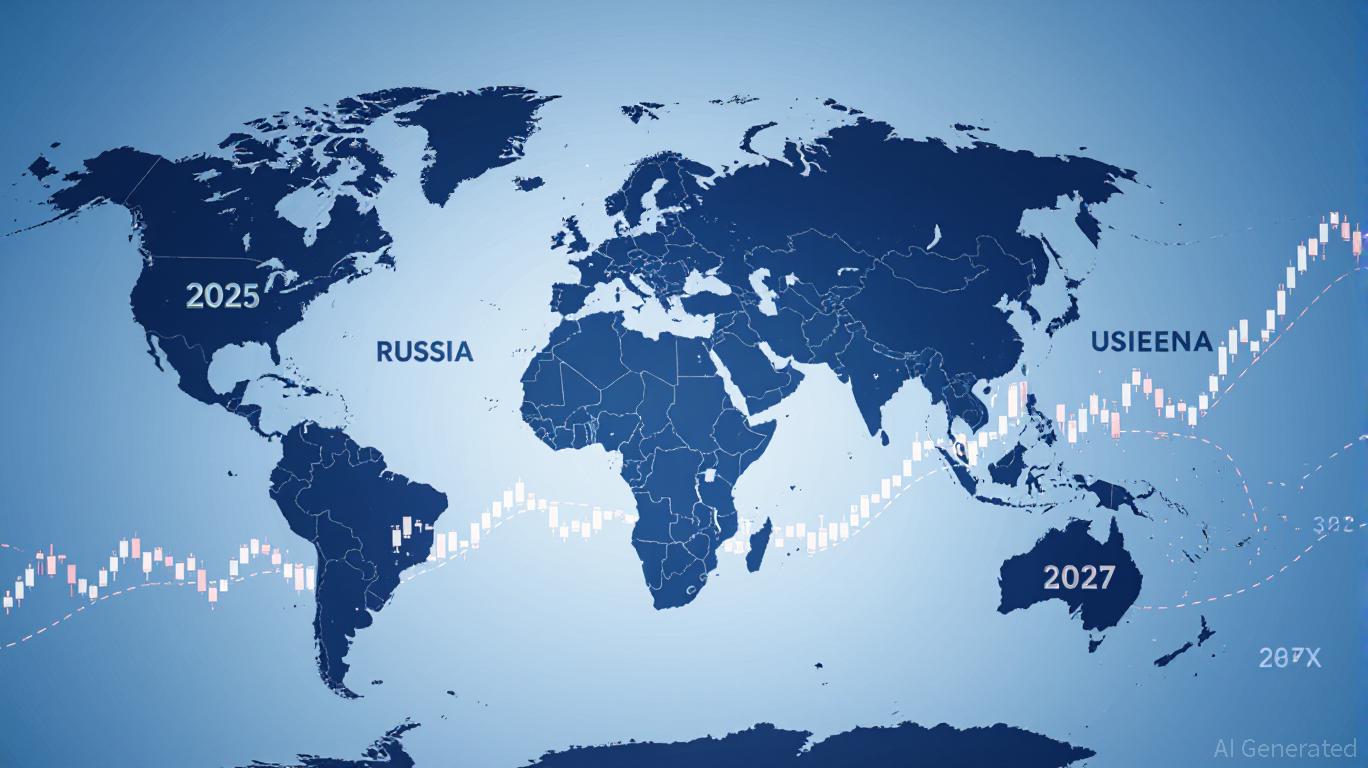
The U.S. dollar, long a pillar of global financial stability, now faces a precarious crossroads. The Federal Reserve’s projected rate cuts and the ambiguous outcome of the Trump-Putin summit in Alaska have created a volatile environment for investors. These dual forces—monetary easing and geopolitical uncertainty—are reshaping currency flows, equity valuations, and asset allocation strategies. For investors, the challenge lies in navigating this duality to identify opportunities while mitigating risks.
The Fed’s Rate Cut Path: A Dollar in Retreat
The Federal Reserve’s latest projections signal a significant shift in monetary policy. By 2027, the central bank anticipates cutting interest rates by 2 percentage points, bringing the federal-funds rate to 2.25%-2.50%. This easing is driven by softening economic growth, the lagging effects of high rates on sectors like housing, and secular trends such as aging demographics and slower productivity. While the Fed aims to return inflation to 2%, the path to normalization is fraught with risks.
A weaker dollar is an inevitable consequence. Lower rates reduce the currency’s appeal to foreign investors, while the yield curve inversion—where long-term yields outpace short-term ones—signals economic fragility. The 10-year Treasury yield is expected to fall to 3.25% by 2028, a stark contrast to the 4.2% average in 2024. This decline will likely weaken the dollar against emerging-market currencies, creating headwinds for U.S. exporters but tailwinds for importers and global investors seeking higher yields elsewhere.
The Trump-Putin Summit: A Geopolitical Wild Card
The August 2025 summit between Donald Trump and Vladimir Putin failed to deliver the diplomatic breakthrough investors had hoped for. While no concrete agreements were reached, the meeting’s ambiguity sent shockwaves through global markets. Russian equities, particularly state-owned energy firms like Gazprom and Rosneft, fell by 2.6–2.9%, while the ruble weakened to 80.15 against the dollar. Defense stocks in Europe also reacted sharply: Rheinmetall dropped 2.77%, and Thales fell 1.52%, reflecting fears of reduced military spending if a ceasefire materializes.
The summit’s lack of resolution has left markets in limbo. Investors are now bracing for a prolonged conflict in Ukraine, which could force European governments to deepen defense spending commitments. NATO’s pledge to increase defense budgets to 5% of GDP by 2035 provides a structural floor for defense stocks, but short-term volatility remains. Meanwhile, Russian oil exports continue to flow via the shadow fleet, with Urals crude trading above the G7+ price cap at $65.1 per barrel in June 2025. This resilience complicates global oil markets, where prices are now more sensitive to geopolitical shifts than supply-side fundamentals.
Strategic Asset Reallocation: Balancing Policy and Geopolitics
The interplay between the Fed’s rate cuts and the Trump-Putin summit demands a nuanced approach to asset allocation. Here are three key strategies:
Overweight Emerging Markets and Commodity Producers
A weaker dollar will bolster emerging-market currencies and equities, particularly in countries with strong trade ties to Russia. India and Turkey, for example, have deepened energy partnerships with Moscow, positioning their energy and refining sectors to benefit from redirected oil flows. Investors should consider exposure to Indian firms like ONGC Videsh and Reliance Industries, as well as Turkish energy infrastructure plays.
Hedge with Defensive Sectors and Commodities
Geopolitical uncertainty elevates the role of safe-haven assets. Gold, which saw a post-summit sell-off, remains a compelling long-term hedge against inflation and currency devaluation. Copper, a proxy for global growth, could also benefit from infrastructure spending in both the U.S. and Europe. Defense stocks with diversified product lines, such as Leonardo (Italy) and Babcock (UK), offer resilience amid shifting military priorities.
Underweight U.S. Dollar-Denominated Assets
As the Fed’s rate cuts erode the dollar’s appeal, investors should reduce exposure to U.S. Treasuries and dollar-based equities. Instead, consider hedging with non-U.S. bonds, particularly in countries with stable fiscal policies. The eurozone’s 10-year bond yield, currently at 2.1%, offers a modest premium over Treasuries, while emerging-market debt, though riskier, provides higher yields in a weaker dollar environment.
Conclusion: Navigating a Fractured Landscape
The dollar’s fragility and the geopolitical stalemate in Ukraine are not isolated events but interconnected forces reshaping global markets. The Fed’s rate cuts will weaken the dollar, while the Trump-Putin summit has underscored the risks of prolonged conflict. For investors, the path forward lies in balancing exposure to emerging markets and commodities with defensive sectors and strategic hedging.
As the Fed continues its easing cycle and geopolitical tensions persist, the ability to adapt quickly will separate successful investors from the rest. The key is to remain agile, monitor central bank signals, and stay attuned to the evolving geopolitical landscape. In this fractured world, opportunity lies not in predicting the future but in preparing for multiple scenarios.
